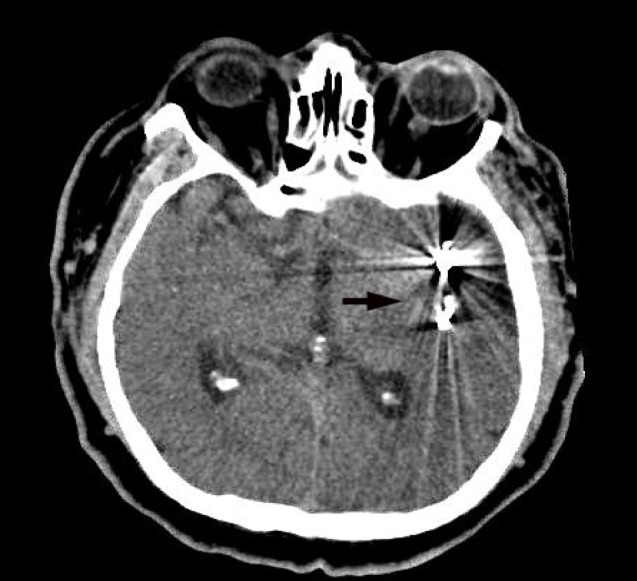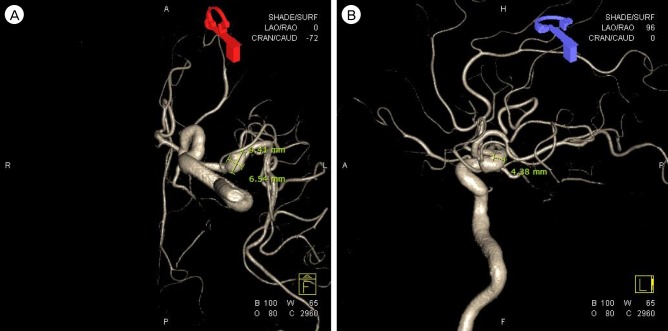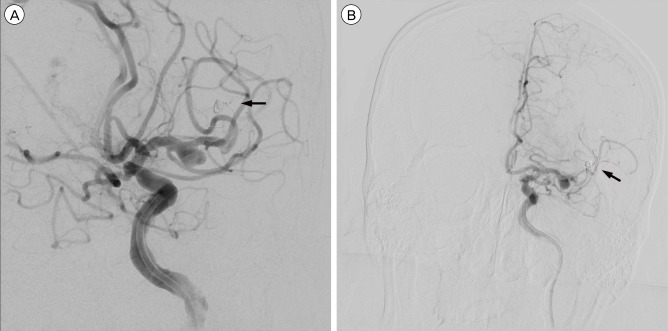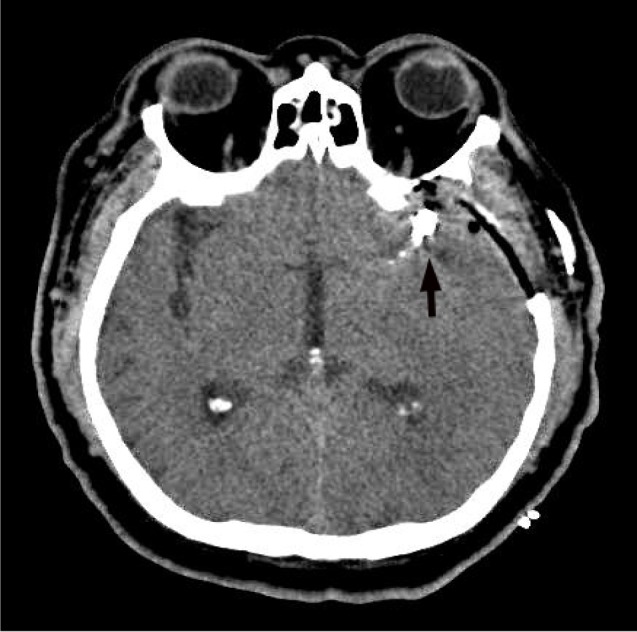J Cerebrovasc Endovasc Neurosurg.
2014 Sep;16(3):287-292. 10.7461/jcen.2014.16.3.287.
Surgical Recanalization of Distal Middle Cerebral Artery Occlusion Due to a Coil Migration During Endovascular Coil Embolization: A Case Report
- Affiliations
-
- 1Department of Neurosurgery, IS Hallym General Hospital, Incheon, Korea. khs501@hanmail.net
- 2Department of Neurosurgery, Research Institute of Clinical Medicine, Chonbuk National University Hospital, Chonbuk National University School of Medicine, Jeonju, Korea.
- KMID: 1963169
- DOI: http://doi.org/10.7461/jcen.2014.16.3.287
Abstract
- Coil migration into the parent artery during endovascular coil embolization is a rare, but life-threatening complication, which can induce thromboembolism and result in poor outcome. A 63-year-old man was referred to Chonbuk National University Hospital emergency center due to migration of a coil for a left middle cerebral artery bifurcation unruptured aneurysm. We performed an emergency craniectomy to remove the coil migrated to the distal M2 branch and thrombus, and aneurysmal neck clipping for his aneurysm. Fortunately, at the six month follow-up, the patient did not show any noticeable neurological sequela. In case of parent artery occlusion due to coil migration an immediate recanalization should be performed by a neurovascular specialist who can provide both surgical treatment and endovascular management in order to prevent severe sequela or even death.
MeSH Terms
Figure
Reference
-
1. Abdihalim M, Kim SH, Maud A, Suri MF, Tariq N, Qureshi AI. Short- and intermediate-term angiographic and clinical outcomes of patients with various grades of coil protrusions following embolization of intracranial aneurysms. AJNR Am J Neuroradiol. 2011; 9. 32(8):1392–1398. PMID: 21885722.
Article2. Chen Z, Tang W, Feng H, Zhu G. Surgical extraction of migrated coils via proximal segment of the anterior cerebral artery: an emergency alternative. Neurol India. 2009; May-Jun. 57(3):327–330. PMID: 19587477.
Article3. Connolly ES Jr, Rabinstein AA, Carhuapoma JR, Derdeyn CP, Dion J, Higashida RT, et al. Guidelines for the management of aneurysmal subarachnoid hemorrhage: a guideline for healthcare professionals from the American Heart Association/American Stroke Association. Stroke. 2012; 6. 43(6):1711–1737. PMID: 22556195.4. Deshmukh VR, Klopfenstein J, Albuquerque FC, Kim LJ, Spetzler RF. Surgical management of distal coil migration and arterial perforation after attempted coil embolization of a ruptured ophthalmic artery aneurysm: technical case report. Neurosurgery. 2006; 4. 58(4 Suppl 2):ONS-E379.5. Hyodo A, Yanaka K, Kato N, Nose T. Coil migration during endovascular treatment in a patient with Galenic arteriovenous malformation. J Clin Neurosci. 2002; 9. 9(5):584–585. PMID: 12383422.
Article6. Khosla A, Brinjikji W, Cloft H, Lanzino G, Kallmes DF. Age-related complications following endovascular treatment of unruptured intracranial aneurysms. AJNR Am J Neuroradiol. 2012; 5. 33(5):953–957. PMID: 22241386.
Article7. Kim KH, Cha KC, Kim JS, Hong SC. Endovascular coiling of middle cerebral artery aneurysms as an alternative to surgical coiling. J Clin Neurosci. 2013; 4. 20(4):520–522. PMID: 23375399.8. Kung DK, Abel TJ, Madhavan KH, Dalyai RT, Dlouhy BJ, Liu W, et al. Treatment of endovascular coil and stent migration using the merci retriever: report of three cases. Case Rep Med. 2012; 2012:242101. PMID: 22666264.
Article9. Lanzino G, Murad MH, d'Urso PI, Rabinstein AA. Coil embolization versus clipping for ruptured intracranial aneurysms: a meta-analysis of prospective controlled published studies. AJNR Am J Neuroradiol. 2013; 9. 34(9):1764–1768. PMID: 23578672.
Article10. Li LF, Leung KM, Lui WM. Surgical recanalisation of thrombosed M2 trunk after coil embolisation of a ruptured middle cerebral artery aneurysm. Hong Kong Med J. 2009; 12. 15(6):482–485. PMID: 19966356.11. Luo CB, Chang FC, Teng MM, Guo WY, Chang CY. Stent management of coil herniation in embolization of internal carotid aneurysms. AJNR Am J Neuroradiol. 2008; 11. 29(10):1951–1955. PMID: 18719031.
Article12. Park JH, Kang HS, Han MH, Jeon P, Yoo DS, Lee TH. Korean Hydrosoft Registry Investigation. Embolization of intracranial aneurysms with HydroSoft coils: results of the Korean multicenter study. AJNR Am J Neuroradiol. 2011; 10. 32(9):1756–1761. PMID: 21920861.
Article13. Park HH, Hong CK, Suh SH, Ahn JY, Joo JY. Management of a complicated cerebral aneurysm with distal migration of a detachable coil: a case report. Korean J Cerebrovasc Surg. 2009; 9. 11(3):118–121.14. Pierot L, Cognard C, Spelle L, Moret J. Safety and efficacy of balloon remodeling technique during endovascular treatment of intracranial aneurysms: critical review of the literature. AJNR Am J Neuroradiol. 2012; 1. 33(1):12–15. PMID: 21349960.
Article15. Wada H, Tokumitsu N, Shirai W, Sako K, Kamada K. Ruptured aneurysm with delayed distal coil migration requiring surgical treatment. Case report. Neurol Med Chir (Tokyo). 2012; 52(6):439–442. PMID: 22729078.16. Wanke I, Doerfler A, Dietrich U, Egelhof T, Schoch B, Stolke D, et al. Endovascular treatment of unruptured intracranial aneurysms. AJNR Am J Neuroradiol. 2002; 5. 23(5):756–761. PMID: 12006272.
- Full Text Links
- Actions
-
Cited
- CITED
-
- Close
- Share
- Similar articles
-
- Management of a Complicated Cerebral Aneurysm with Distal Migration of a Detachable Coil: A Case Report
- Retrieval of Unintended Migrated Detached Coil: Case Report
- Surgical Removal of Coil and Clipping of Aneurysm after Failure of Intraaneurysmal Coil Embolization: Case Report
- Acute frame coil migration during filling coil retrieval in a cerebral aneurysm embolization case: A possible result of a venturi effect?
- Rescue Balloon Reposition of the Protruding Coil Loops during Endovascular Treatment of An Anterior Communicating Artery Aneurysm: A Case Report







